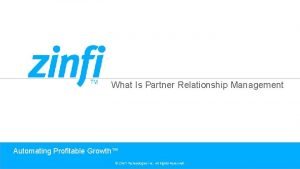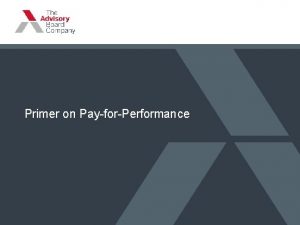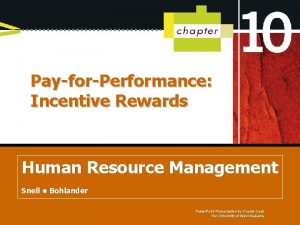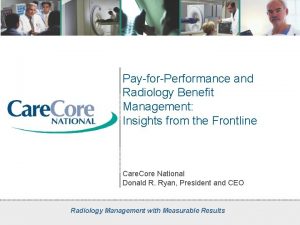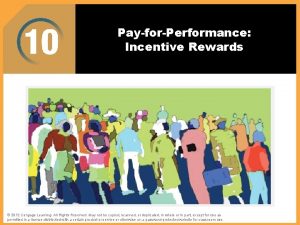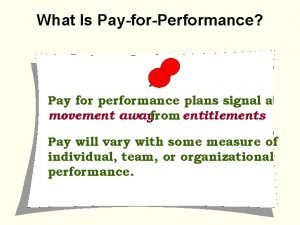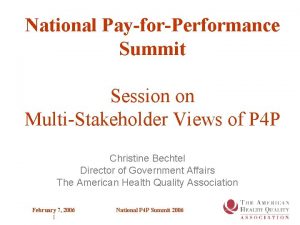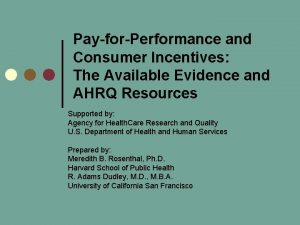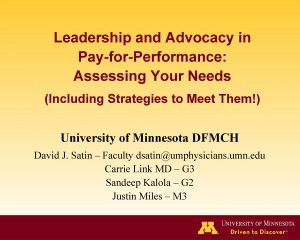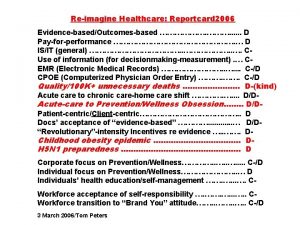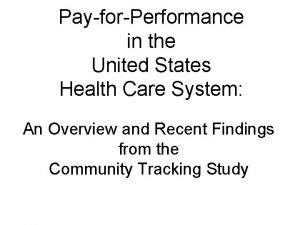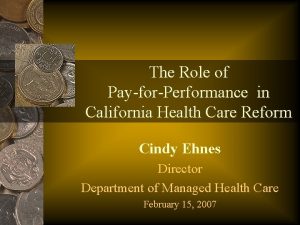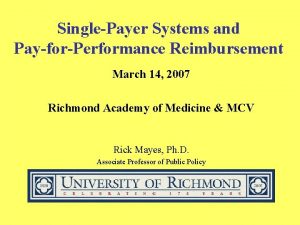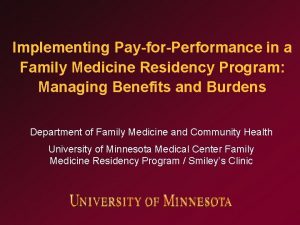Disease Management A New Partner in the PayforPerformance





























- Slides: 29

Disease Management: A New Partner in the Pay-for-Performance Era Mary Jane Osmick M. D. Vice President and Medical Director Life. Masters Self-Supported Care, Inc. © 2008 Life. Masters – Proprietary & Confidential

Agenda • The Cost of Chronic Disease • DM 101 • Disease Management as a Platform for Practice Integration • DM Program Results – It’s Working • How can DM help you in P 4 P? © 2008 Life. Masters – Proprietary & Confidential 2

The Cost of Chronic Disease Chronic disease affects ~1/3 of the population but account for ~ 2/3 of Medicare allowed spending % of Total Population % of Medicare Allowed Spending Year Chronic Non-Chronic 2002 32. 5% 67. 5% 65. 6% 34. 4% 2003 33. 0% 67. 0% 65. 7% 34. 3% 2004 33. 6% 66. 4% 65. 8% 34. 2% 2005 33. 7% 66. 3% 65. 7% 34. 3% 2006 33. 7% 66. 3% 64. 6% 35. 4% © 2008 Life. Masters – Proprietary & Confidential 3

The Cost of Chronic Disease Medicare PMPM spend for chronic disease is about 3 -4 X that of nonchronic disease Year Chronic 2002 $1, 233 $310 2003 $1, 284 $329 2004 $1, 364 $357 2005 $1, 435 $381 2006 $1473 $410 © 2008 Life. Masters – Proprietary & Confidential 4 Non-Chronic

Chronic Conditions – US Prevalence and Expenditures Total Indirect Expenditure Direct* Expenditure per Year (billions) Lost Productivity / Morbidity Lost Productivity/ Mortality $68. 80 $10. 20 $58. 60 $116 $58. 00 $31. 10 $26. 90 $69. 40 $51. 30 $18. 10 $10 11. 2 $37. 20 $20. 90 $16. 30 5. 3 $34. 80 $31. 70 $3. 10 Asthma: adults & children (3) 22. 2 $18 $10 $8 Low Back Pain 22. 4 $32 $50 - $100 Disease State CAD Diabetes (1) Hypertension COPD (2) CHF Prevalence (millions)* Total Expenditure per Year (billions) 16 $156. 40 $87. 60 23. 6 $174 73 Total Indirect** Expenditure per Year (billions) © 2008 Life. Masters – Proprietary & Confidential 5 $3. 10

Timeline in Managing Chronic Disease $$$ Quality of life Care Cost High $ Low DEATH 10 0 15 Time in years = Disease exacerbation © 2008 Life. Masters – Proprietary & Confidential 6 17 19

What Did Disease Management Originally Mean? Population Risk Segments © 2008 Life. Masters – Proprietary & Confidential 7

What Does DM Address Now? Population Risk Segments © 2008 Life. Masters – Proprietary & Confidential 8

Care Delivery Value Chain Chronic Kidney Disease – a Complex System Knowledge Mgmt Diet Explanation Of Dx Inform Cr GFR protein Ultrasound Angio Biopsy Nuclear scan Office and Lab visits Office and lab visits Monitor and prevent Diagnose Measure Access Education on procedures Medication counseling Lifestyle Counseling Pretesting Procedure specific measures Kidney Function tests Bone metabolism Anemia Kidney function tests Office and Hospital visits Office, lab Telephone visits Office, lab and Telephone visits Intervene Recovery Monitoring and Managing Various Prepare Medication F/U Renal transplant counseling Nephrologists and other providers need seamless integration © 2008 Life. Masters – Proprietary & Confidential 9 Patient Value Health results per unit of cost

DM Population Health Improvement Model • • Strategy and process to identify the population Comprehensive patient needs assessment Proactive health promotion to increase risk awareness Patient-centric health management goals and education Support patient and primary care provider Coach individuals to make behavioral changes Report/feedback to patient, physicians, health plan and other providers • Evaluate and report clinical and economic outcomes with the goal of improving overall population health © 2008 Life. Masters – Proprietary & Confidential 10

Disease Management Goals • Promote population health improvement • Facilitate/coordinate care across the continuum • Improve the quality of health care and outcomes by: • Reducing preventable health care costs • Promoting health and wellness • Helping to manage chronic conditions © 2008 Life. Masters – Proprietary & Confidential 11

Disease Management Should NOT be… • A force that gets between you and your patient • Care delivery for patients that does not meet your approval • A way for health plans to deny care • A system “outside of” evidence-based, mainstream medical care • Another voice of fragmentation • A waste of time, money, and precious resources © 2008 Life. Masters – Proprietary & Confidential 12

Identification & Stratification & Improvement Client and Vendor Data Medical Claims ∙ Eligibility ∙ Lab Results Hospital Discharges ∙ Providers ∙ HRA Data Pharmacy Claims ∙ Workers’ Comp ∙ Vision Mental Health ∙ Other • Apply Suite of Technology Pervasive Predictive Model Proprietary Algorithms Ingenix Pro Toolset Medisave Diabetes Fair. Isaac Identification, risk stratification and further segmentation to locate and enroll participants Low Risk Eligibles Member may be eligible for multiple programs Moderate Risk Eligibles Member may be eligible for multiple programs Health Activation – willingness to play a role in health care Results: Reports that Show Value to Clients, Participants, and Physicians © 2008 Life. Masters – Proprietary & Confidential 13 High Risk Eligibles

Unique Coaching Model Drives Better Outcomes • Identified participant works with Health Professional, creating trust and driving ongoing engagement • U. of Oregon/Brandeis U. study demonstrated improved outcomes by tailoring coaching over standard “information giving” • Patient Activation Measure segments the population • “Motivational Interviewing” supports overcoming barriers to behavior change © 2008 Life. Masters – Proprietary & Confidential 14 Patent Pending

DM as a Platform for Physician Integration © 2008 Life. Masters – Proprietary & Confidential 15

Disease Management as Platform for Physician Integration • Provides real-time, actionable information to support the plan of care • Incorporates easily into existing practice patterns • Provides data and support for Medical Home and P 4 P initiatives • Enhances participant engagement and improves outcomes © 2008 Life. Masters – Proprietary & Confidential 16

Research on Physician Response to Health Alerts • Health Alerts are generated from an information technology system that tracks clinical indicators, biometrics, claims data and nurse assessments against thresholds derived from evidence-based, national guidelines or physician-specific input • Health Alerts provide real-time information on changes in the clinical status of their patients • Health Alerts provide opportunity to intervene early to avoid exacerbations and make course corrections in the treatment plan • Health Alerts “out of bounds” events are triaged by a nurse to determine those that should be acted on by the physician © 2008 Life. Masters – Proprietary & Confidential 17

Research on Physician Response to Health Alerts Methodology • Research based on 104, 000 Health Alerts by Life. Masters between January 2005 and March 2008 Findings • 60% of physician follow up activities occurred within 2 days of the alert being sent. • 87% of physician follow-up activities occurred within 5 days • 98% of all follow-up activities by physicians occurred within 15 days. • >85 % of the time, physicians responded to Health Alert results with treatment plan course corrections © 2008 Life. Masters – Proprietary & Confidential 18

Most Common Conditions to Generate Alerts • Congestive heart failure (33%) • Diabetes (25%) • Coronary Artery Disease (20%) • Cancer (2 to 4%) • Other (remainder) © 2008 Life. Masters – Proprietary & Confidential 19

Resulting Physician Interventions Over 39 -months, physicians ordered interventions for patients as a result of Health Alerts • • Saw physician in office – 52% Had a lab test – 12% Seen in the ER – 7% Admitted to hospital – 4% Started on new medication – 11% Medication dosage changed – 6% Other medication change – 2% Other new physician instructions – 17% © 2008 Life. Masters – Proprietary & Confidential 20

DM Program Results – It’s Working • Fewer hospitalizations, ER visits, and general utilization decreases because participants are clinically improved • As clinical outcomes improve, so does savings • Case study: total population, raw claims, no adjustments © 2008 Life. Masters Supported Self. Care, Inc. © 2008 Life. Masters – Proprietary & Confidential 21

DM Program Results – It’s Working • “LOTIP” : Length of Time in Program • Clinical outcomes improve the longer participants stay in our program • Case study : Diabetes (in months) Improvement in all diabetes metrics with increased time in program; excepting for Influenza vaccination and LDL<100 which decreased (dotted lines = trend lines) © 2008 Life. Masters – Proprietary & Confidential 22

DM Program Results – It’s Working Participant Satisfaction with the Program © 2008 Life. Masters Supported Self. Care, Inc. © 2008 Life. Masters – Proprietary & Confidential 23

Example: P 4 P with DM • Life. Masters contracts with provider network in South Florida whose mission is solely to introduce DM to physicians • Supports concept of the Medical Home • Aim to successfully engage 33 to 50% of the total physicians in Miami Dade County at a minimum rate of 10 providers per week • Physicians receive per-member per-month fees for each patient engaged in the program and incremental increases the longer the participant remains in the program • P 4 P bonuses offered for practices with improved outcomes • Physician agrees to respond to the Health Alerts and complete satisfaction survey © 2008 Life. Masters – Proprietary & Confidential 24

Are you ready for P 4 P? P 4 P program growth from 39 to 148 from 2003 -2007 Do you know where your patients are? • How many diabetics reside within your practice? • Who are they? • Do you see them regularly • What % meet A 1 c guidelines? Which do not? • What were the results of your entire population? • What do you need to do to earn a performance bonus? • Who is getting you integrated data and information? • Who is helping you reach these patients and the goals? © 2008 Life. Masters – Proprietary & Confidential 25

How can DM help in a P 4 P environment? • Aggregate & report patient data and results • Help educate and focus patients on needed lifestyle change • Improve adherence to care, persistence with meds • Help “de-hassle” your office – less calls, unnecessary visits, interruptions, missed tests etc. • Increase patient satisfaction • Decrease patient risk © 2008 Life. Masters – Proprietary & Confidential 26

Talk to your patients about DM • “Your employer has provided you an important healthcare benefit – disease management. Let me tell you about it. You may get a call from a nurse – please listen carefully to what he/she has to offer. ” • “Your DM nurse will not replace me. She will help you and me between visits by making sure you can better care for yourself. If she sees any problems starting between visits, she’ll let me know. ” • “Think of your nurse as a personal health coach. Call her if you can’t reach me and you have a question that isn’t an emergency. Then we can talk about that when I see you next time. ” • “Think about the things in your health you’d like to change. Talk to me and get support from you DM nurse about these changes. They are important. ” © 2008 Life. Masters – Proprietary & Confidential 27

Disease Management Take Home Messages • DM is here to help, not hurt • DM works with the whole care continuum • DM supports the physician plan of care • DM nurse/coaches help patients become better selfmanagers • DM has information technology to track patient care and outcomes © 2008 Life. Masters – Proprietary & Confidential 28

Questions © 2008 Life. Masters – Proprietary & Confidential 29
 Communicable disease and non communicable disease
Communicable disease and non communicable disease Partner relationship management best practices
Partner relationship management best practices Define partner relationship management
Define partner relationship management Limited partner cash management
Limited partner cash management Hình ảnh bộ gõ cơ thể búng tay
Hình ảnh bộ gõ cơ thể búng tay Lp html
Lp html Bổ thể
Bổ thể Tỉ lệ cơ thể trẻ em
Tỉ lệ cơ thể trẻ em Gấu đi như thế nào
Gấu đi như thế nào Thang điểm glasgow
Thang điểm glasgow Bài hát chúa yêu trần thế alleluia
Bài hát chúa yêu trần thế alleluia Môn thể thao bắt đầu bằng từ chạy
Môn thể thao bắt đầu bằng từ chạy Thế nào là hệ số cao nhất
Thế nào là hệ số cao nhất Các châu lục và đại dương trên thế giới
Các châu lục và đại dương trên thế giới Công thức tiính động năng
Công thức tiính động năng Trời xanh đây là của chúng ta thể thơ
Trời xanh đây là của chúng ta thể thơ Mật thư anh em như thể tay chân
Mật thư anh em như thể tay chân 101012 bằng
101012 bằng độ dài liên kết
độ dài liên kết Các châu lục và đại dương trên thế giới
Các châu lục và đại dương trên thế giới Thơ thất ngôn tứ tuyệt đường luật
Thơ thất ngôn tứ tuyệt đường luật Quá trình desamine hóa có thể tạo ra
Quá trình desamine hóa có thể tạo ra Một số thể thơ truyền thống
Một số thể thơ truyền thống Cái miệng nó xinh thế
Cái miệng nó xinh thế Vẽ hình chiếu vuông góc của vật thể sau
Vẽ hình chiếu vuông góc của vật thể sau Nguyên nhân của sự mỏi cơ sinh 8
Nguyên nhân của sự mỏi cơ sinh 8 đặc điểm cơ thể của người tối cổ
đặc điểm cơ thể của người tối cổ Thứ tự các dấu thăng giáng ở hóa biểu
Thứ tự các dấu thăng giáng ở hóa biểu Vẽ hình chiếu đứng bằng cạnh của vật thể
Vẽ hình chiếu đứng bằng cạnh của vật thể Tia chieu sa te
Tia chieu sa te


